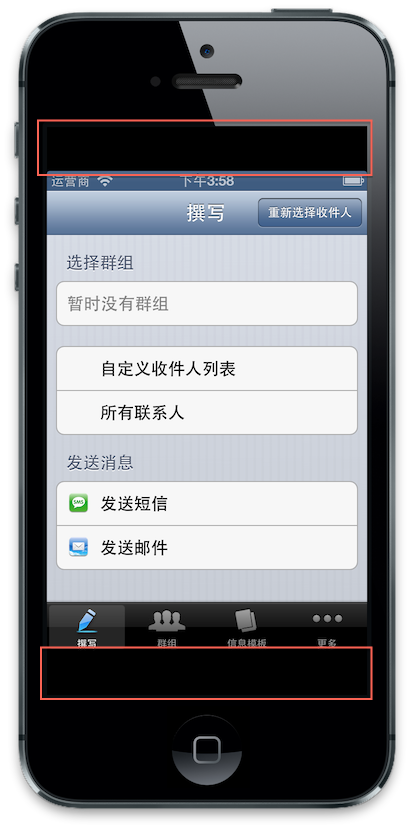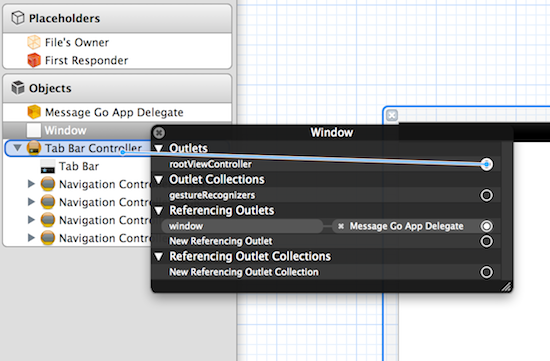iPhone 5 和 iOS 6 正式发布后,iOS 开发者们就要开始做 iPhone 5 和 iOS 6 的适配工作了 :)
在迁移我自己的几个 iOS App 过程中,发现了老的 Xcode 工程代码在 iOS 6 中无法响应屏幕旋转的问题,在这里记录一下。顺便记录一下怎样适配 iOS App 到 iPhone 5 给还不知道怎么做的朋友们。
适配 iPhone 5 的 4 寸屏幕

iOS App LetterBox Mode
iPhone 5 的屏幕分辨率为 640x1136,默认情况下,老的 iOS App 会以上下加两条黑边的模式来运行,程序实际占用的分辨率还是 640x960,保证了原有的 iOS App 在不修改的情况下也可以正常运行。
如果需要适配 iPhone 5 的 4 寸屏幕,是一件很简单的事,只需要添加一张对应 iPhone 5 启动图片即可。
iPhone 5 的分辨率为 640x1136,所以只需要添加一张分辨率为 640x1136 的启动图片到 iOS App 工程即可。启动图片需要命名为 [email protected],因为 iPhone 5 没有非 Retina 屏幕的型号,所以不需要 Default-568h.png 这样一个文件了。
添加了对应 iPhone 5 分辨率的启动图片后,iOS App 就会以 640x1136 的分辨率运行了。
当然了,如果 iOS App 里在计算 view 的 frame 时,使用了固定的 320x480 来计算的话,在显示时就会有一些问题,这时候就需要动态根据 view 的 frame 大小去计算,而不是使用 Hard Code。
另外,也可以灵活使用 autoresizingMask,这样在未来 iPhone 又有其他分辨率,又或者出现了 iPad mini 的时候更方便处理。
解决旧的 iOS App 在 iOS 6 中无法随屏幕旋转的问题
如果你的 iOS App 支持随屏幕旋转而旋转,但是到了 iOS 6 中,发现这个功能不生效了,那么就要检查一下是不是因为旧版本的 Xcode 创建工程的原因。
但是在 iOS SDK Release Notes for iOS 6.0 中的 UIKit 一节中说到“Autorotation is changing in iOS 6. In iOS 6, the shouldAutorotateToInterfaceOrientation: method of UIViewController is deprecated. In its place, you should use the supportedInterfaceOrientationsForWindow: and shouldAutorotate methods.”,并且详细解释中也说明了 iOS 6 中的改动:
More responsibility is moving to the app and the app delegate. Now, iOS containers (such as UINavigationController) do not consult their children to determine whether they should autorotate. By default, an app and a view controller’s supported interface orientations are set to UIInterfaceOrientationMaskAll for the iPad idiom and UIInterfaceOrientationMaskAllButUpsideDown for the iPhone idiom.
A view controller’s supported interface orientations can change over time—even an app’s supported interface orientations can change over time. The system asks the top-most full-screen view controller (typically the root view controller) for its supported interface orientations whenever the device rotates or whenever a view controller is presented with the full-screen modal presentation style. Moreover, the supported orientations are retrieved only if this view controller returns YES from its shouldAutorotate method. The system intersects the view controller’s supported orientations with the app’s supported orientations (as determined by the Info.plist file or the app delegate’s application:supportedInterfaceOrientationsForWindow: method) to determine whether to rotate.
The system determines whether an orientation is supported by intersecting the value returned by the app’s supportedInterfaceOrientationsForWindow: method with the value returned by the supportedInterfaceOrientations method of the top-most full-screen controller.
The setStatusBarOrientation:animated: method is not deprecated outright. It now works only if the supportedInterfaceOrientations method of the top-most full-screen view controller returns 0. This makes the caller responsible for ensuring that the status bar orientation is consistent.
For compatibility, view controllers that still implement the shouldAutorotateToInterfaceOrientation: method do not get the new autorotation behaviors. (In other words, they do not fall back to using the app, app delegate, or Info.plist file to determine the supported orientations.) Instead, the shouldAutorotateToInterfaceOrientation: method is used to synthesize the information that would be returned by the supportedInterfaceOrientations method.
说明中提到,在 iOS 6 中系统会通过查询 rootViewController 来判断是否可以旋转视图,但是在以前,使用 Xcode 创建一个工程时,通常会有以下代码来显示主窗口:
- (BOOL)application:(UIApplication *)application didFinishLaunchingWithOptions:(NSDictionary *)launchOptions {
// Add the tab bar controller's view to the window and display.
[self.window addSubview:tabBarController.view];
[self.window makeKeyAndVisible];
return YES;
}
在这里,并没有设置 self.window 的 rootViewController,而且在 MainWindow.xib 中,也没在连接 window 的 rootViewController 到默认的 UITabBarController。
因此,我们有两种方法来解决这个问题:
1. 在代码中设置 rootViewController
- (BOOL)application:(UIApplication *)application didFinishLaunchingWithOptions:(NSDictionary *)launchOptions {
// Add the tab bar controller's view to the window and display.
self.window.rootViewController = tabBarController;
[self.window addSubview:tabBarController.view];
[self.window makeKeyAndVisible];
return YES;
}
2. 在 MainWindow.xib 中连接 window 的 rootViewController

两种方法任意选择一种就行了。
当然使用新版本 Xcode 创建的工程应该是没问题的,而且新版本 Xcode 的工程模板通常会使用代码来创建 rootViewController,而且默认也不再生成 MainWindow.xib。
参考资料
---EOF---

Nice :grin:
哈,期待厚厚更多大作